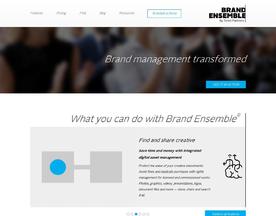Brand architecture is a crucial aspect of any business strategy that involves the organization and structure of a company’s brand portfolio. It encompasses the way a company’s brands are organized, managed, and presented to the market. Effective architecture can help a company to differentiate its brands, increase brand awareness, and maximize its overall market value.

At its core, branding is about creating a logical and coherent structure for a company’s brand portfolio. This involves defining the relationships between the various brands within the portfolio, as well as determining how they are presented to customers. A well-designed brand architecture can help customers to understand the company’s products and services, and make more informed purchasing decisions.
There are various types of branding architecture that companies can use, depending on their specific needs and goals. These range from a “house of brands” approach, where each brand within the portfolio operates independently, to a “branded house” approach, where all brands are sub-brands of a single master brand. Understanding the different types of branding, and how they can be used effectively, is essential for any company looking to build a strong and effective brand portfolio.
Key Takeaways
- Branding involves the organization and structure of a company’s brand portfolio
- Effective branding can help a company to differentiate its brands and maximize its market value
- There are various types of branding that companies can use, depending on their needs and goals.
Fundamentals of Brand Architecture
Defining Brand Architecture
Brand architecture refers to the way an organization structures and organizes its brands, products, and services. It involves creating a framework that outlines how different brands and products relate to each other and to the overall organization. This framework helps to ensure consistency in brand messaging and positioning, and can help to maximize brand equity.
There are different types of architectural branding, including:
- Monolithic: In this type of architecture, all products and services are marketed under a single brand name. This approach can help to create a strong brand identity and can be particularly effective for organizations with a strong reputation.
- Endorsed: In an endorsed architecture, products and services are marketed under their own brand names, but are endorsed by the parent brand. This approach can help to leverage the reputation of the parent brand while still allowing for individual product identities.
- Freestanding: In a freestanding architecture, each product or service is marketed under its own brand name, with no connection to the parent brand. This approach can allow for greater flexibility and can be particularly effective for organizations with diverse product offerings.
Importance of Brand Architecture
Effective architectural branding is essential for organizations looking to build and maintain strong brands. It can help to:
- Maximize brand equity: By creating a clear framework for brand messaging and positioning, architectural branding can help to maximize the value of a brand.
- Ensure consistency: By establishing clear guidelines for how different brands and products relate to each other, architectural branding can help to ensure consistency in brand messaging and positioning.
- Facilitate brand management: By providing a clear framework for managing different brands and products, brand architecture can help to streamline brand management and ensure that resources are allocated effectively.
Overall, effective architectural branding is an essential component of any successful brand strategy. By creating a clear framework for how different brands and products relate to each other, organizations can maximize the value of their brands and ensure consistency in brand messaging and positioning.
To learn more about architectural branding, check out this article by Interbrand, a leading brand consultancy.
Types of Brand Architecture
There are various types of architectural branding used by companies to structure their brands. Each type has its own unique characteristics, advantages, and disadvantages. In this section, we will discuss the four main types of brand architecture: Branded House, House of Brands, Hybrid Brand Architecture, and Endorsed Brands.
Branded House
In a Branded House model, also known as an Umbrella Brand or Master Brand, all products and services are marketed under one brand. The parent brand is the main focus, and the sub-brands, if any, are secondary. The sub-brands have a clear connection to the parent brand and are used to differentiate products or services within the same brand family. This type of brand architecture is commonly used by companies such as Virgin and Apple.
House of Brands
In a House of Brands model, also known as a Pluralistic Brand Architecture, each product or service has its own brand identity. The parent company is not usually visible to the consumer, and each brand operates independently. This type of brand architecture is commonly used by large corporations such as Procter & Gamble, which owns various brands such as Tide, Pampers, and Gillette.
Hybrid Brand Architecture
A Hybrid Brand Architecture model combines elements of both Branded House and House of Brands models. In this type of brand architecture, the parent brand is visible, but each sub-brand has its own unique identity. This type of brand architecture is commonly used by companies such as Nestle, which owns various sub-brands such as KitKat, Nescafe, and Gerber.
Endorsed Brands
In an Endorsed Brand model, also known as an Endorsement Brand Architecture, the parent brand is visible but takes a back seat to the sub-brand. The sub-brand is the main focus, and the parent brand is used to provide credibility or endorsement to the sub-brand. This type of brand architecture is commonly used by companies such as Marriott, which owns various sub-brands such as Ritz-Carlton, Courtyard, and Residence Inn.
To learn more about the different types of brand architecture, check out this article by Branding Strategy Insider.
Strategic Development of Brand Architecture
Developing a brand architecture that aligns with the business goals and effectively communicates the brand’s positioning and messaging to the target market is crucial for building a strong brand identity. The strategic development of brand architecture involves considering various factors, including market segmentation, brand positioning, and messaging.
Aligning Strategy with Business Goals
The brand architecture should be developed in line with the overall business strategy to ensure that it supports the business goals. This involves identifying the key business objectives and aligning the brand architecture to support these objectives. For instance, if the business goal is to increase market share, the brand architecture should be designed to appeal to a wider audience and differentiate the brand from competitors.
Considering Market Segmentation
Market segmentation is an essential factor to consider when developing a brand architecture. Understanding the target market and their needs and preferences is crucial for developing a brand architecture that resonates with them. The brand architecture should be designed to appeal to the target market and differentiate the brand from competitors.
Brand Positioning and Messaging
Brand positioning and messaging play a critical role in the development of brand architecture. The brand positioning should be based on a unique value proposition that differentiates the brand from competitors. The messaging should be clear, concise, and consistent across all brand touchpoints.
To develop an effective brand architecture, it is essential to consider all the above factors and ensure that they are aligned with the overall business strategy. A well-designed brand architecture can help build a strong brand identity and increase brand equity.
For more information on strategic development of brand architecture, refer to this article by Forbes Agency Council.
Brand Architecture in Practice

Brand architecture is the way a company organizes and presents its brands to the world. It is a key aspect of a company’s overall marketing strategy. In practice, brand architecture can take many forms, from simple to complex. This section will explore some examples of brand architecture in practice, as well as its relationship to corporate identity.
Case Studies
Apple
Apple is a company that has a well-defined brand architecture. The company’s main brand is Apple, and it has several sub-brands, including iPhone, iMac, iPad, Watch, and TV. Each of these sub-brands has its own distinct identity, but they are all clearly linked to the Apple brand. This approach allows Apple to leverage the strength of its main brand while also giving each sub-brand room to grow and develop.
FedEx
FedEx is another company that has a well-defined brand architecture. The company has three main brands: FedEx Express, FedEx Freight, and FedEx Ground. Each of these brands has its own distinct identity, but they are all clearly linked to the FedEx brand. This approach allows FedEx to offer a range of services while still maintaining a consistent brand identity.
Unilever
Unilever is a company that has a complex brand architecture. The company has many sub-brands, including Tide, Pampers, Oral-B, and Gillette. Each of these sub-brands has its own distinct identity, but they are all linked to the Unilever brand. This approach allows Unilever to offer a wide range of products while still maintaining a consistent brand identity.
Brand Architecture and Corporate Identity
Brand architecture is closely linked to corporate identity. A company’s brand architecture should reflect its overall corporate identity and values. For example, a company that values innovation and creativity may have a more complex brand architecture, while a company that values simplicity and efficiency may have a simpler brand architecture.
In conclusion, brand architecture is an important aspect of a company’s overall marketing strategy. It allows a company to organize and present its brands in a way that is consistent with its corporate identity and values. By understanding the different approaches to brand architecture, companies can create a brand strategy that is effective and sustainable.
Here is a link to Interbrand’s methodology for evaluating brand value, which is a useful resource for understanding the importance of brand architecture.
Managing Brand Architecture

Brand architecture is the way a company organizes and structures its portfolio of brands to create a cohesive and effective brand strategy. Managing brand architecture involves making strategic decisions about how to structure the brand portfolio, how to integrate new brands after mergers and acquisitions, and how to create brand extensions and sub-brands.
Brand Portfolio Management
Brand portfolio management is the process of managing a company’s portfolio of brands to optimize brand awareness, revenue, and customer loyalty. This involves making strategic decisions about which brands to keep, which to divest, and how to allocate resources across the portfolio. It also involves creating a clear brand promise and ensuring that each brand delivers on that promise.
One approach to brand portfolio management is to use a “house of brands” strategy, where each brand operates independently and has its own unique identity. Another approach is to use a “branded house” strategy, where all brands are sub-brands of a parent company and share a common brand identity.
Mergers, Acquisitions, and Brand Architecture
Mergers and acquisitions can pose challenges for brand architecture, as companies must integrate new brands into their existing portfolio while maintaining a strong brand identity. One approach is to use a “brand consolidation” strategy, where the acquired brand is phased out and integrated into the parent company’s brand portfolio. Another approach is to use a “brand extension” strategy, where the acquired brand is maintained as a separate brand within the portfolio.
When integrating new brands, it is important to consider factors such as brand awareness, customer loyalty, and revenue potential. Cross-promotion and cross-selling can be effective ways to leverage the strengths of different brands within the portfolio.
Brand Extensions and Sub-Branding
Brand extensions and sub-branding can be effective ways to leverage the strength of a strong brand and expand into new markets. Brand extensions involve creating new products or services under an existing brand name, while sub-branding involves creating a new brand identity within the existing brand portfolio.
When creating brand extensions or sub-brands, it is important to consider factors such as brand equity, brand awareness, and customer loyalty. It is also important to ensure that the new brand aligns with the parent brand’s overall brand promise and values.
One example of successful brand architecture is Alphabet, the parent company of Google. Alphabet uses a “branded house” strategy, where all brands are sub-brands of the parent company and share a common brand identity. This approach has helped Alphabet maintain a strong brand identity and leverage the strengths of its various brands.
To learn more about managing brand architecture, check out this article from Harvard Business Review: The Right Way to Manage Your Brand Portfolio.
Impact of Brand Architecture on Business Performance

Brand architecture refers to the way a company organizes and structures its brands and sub-brands. A well-designed brand architecture can have a significant impact on a business’s overall performance and success. In this section, we will explore the various ways in which brand architecture can affect a company’s revenue, market presence, brand loyalty, customer base, employee engagement, and brand advocacy.
Revenue and Market Presence
A well-thought-out brand architecture can help a company increase revenue and market presence by providing a clear and consistent message to customers. By ensuring that all brands and sub-brands are aligned with the company’s overall value proposition, customers are more likely to recognize and trust the company’s products or services. This can lead to increased sales and market share.
According to a study by Interbrand, companies with a strong brand architecture strategy saw a 12.4% increase in revenue compared to those without one. This demonstrates the significant impact that brand architecture can have on a company’s bottom line.
Brand Loyalty and Customer Base
Brand architecture can also play a crucial role in building brand loyalty and a strong customer base. By creating a clear hierarchy of brands and sub-brands, customers can easily understand the relationship between different products and services. This can lead to increased trust and loyalty towards the company’s brands.
In addition, a well-designed brand architecture can help a company target specific customer segments more effectively. By creating distinct sub-brands for different market segments, companies can tailor their messaging and product offerings to better meet the needs and preferences of each group.
Employee Engagement and Brand Advocacy
Brand architecture can also have a significant impact on employee engagement and brand advocacy. By providing a clear and consistent message to employees, they are more likely to understand and embrace the company’s overall value proposition. This can lead to increased employee satisfaction and motivation, which can translate into better customer experiences and increased brand advocacy.
According to a study by Gallup, companies with engaged employees saw a 21% increase in profitability compared to those without. This highlights the importance of employee engagement and the role that brand architecture can play in achieving it.
Overall, brand architecture is a critical component of any company’s overall strategy. By ensuring that all brands and sub-brands are aligned with the company’s overall value proposition, companies can increase revenue, market presence, brand loyalty, customer base, employee engagement, and brand advocacy.
Future Trends in Brand Architecture

As the business landscape continues to evolve, so does the concept of brand architecture. Companies are constantly exploring new ways to structure their brands to better align with their business objectives and stay ahead of the curve. Here are some future trends in brand architecture that are likely to shape the industry in the coming years.
Innovation and Diversification
Innovation and diversification are key drivers of brand architecture in the modern era. Companies are increasingly looking to expand their product lines and offerings to cater to a wider audience. This trend is particularly evident in the services sector, where companies are diversifying their service offerings to attract new customers.
One example of this trend is the healthcare industry, where companies are expanding their product lines to include wellness and fitness products in addition to traditional healthcare services. This trend is likely to continue as companies look for new ways to differentiate themselves in a crowded market.
Digital Transformation
Digital transformation is another trend that is likely to shape the future of brand architecture. As companies increasingly rely on digital channels to reach their customers, they are rethinking their marketing strategies and product offerings to better align with digital trends.
One example of this trend is the rise of direct-to-consumer (DTC) brands, which are built around a digital-first approach to marketing and sales. These brands are disrupting traditional retail channels by offering unique product offerings and personalized experiences to customers.
As companies continue to embrace digital transformation, they will need to rethink their brand architecture to stay relevant in an increasingly digital world.
To learn more about the future of brand architecture, check out this article by McKinsey & Company.
Implementing a Brand Architecture Framework

A brand architecture framework is a vital tool for brand strategists to manage and organize their brand portfolio. It provides a clear roadmap for how a company’s brands relate to each other, and how they fit into the overall marketing and corporate strategy. Implementing a brand architecture framework involves developing a coherent framework and integrating it with marketing and corporate strategy.
Developing a Coherent Framework
Developing a coherent framework involves defining the relationships between the various brands in a company’s portfolio. An architectural branding framework typically includes the following components:
- Brand hierarchy: This refers to the structure of the brand portfolio, including the relationship between the corporate brand and its sub-brands.
- Brand roles: This refers to the specific role that each brand plays in the portfolio, such as a master brand, a product brand, or a sub-brand.
- Brand identities: This refers to the visual and verbal elements that differentiate each brand from the others in the portfolio.
To develop a coherent framework, brand strategists need to conduct a thorough analysis of their brand portfolio. This includes identifying the strengths and weaknesses of each brand, as well as the opportunities and threats in the marketplace. Once this analysis is complete, the brand strategist can develop an architectural branding framework that aligns with the company’s overall marketing and corporate strategy.
Integration with Marketing and Corporate Strategy
Integrating the architectural branding framework with marketing and corporate strategy is critical for ensuring that the brand portfolio is aligned with the company’s overall goals and objectives. This involves:
- Aligning the brand hierarchy with the company’s organizational structure and business units.
- Developing a marketing strategy that leverages the strengths of each brand in the portfolio.
- Ensuring that the brand identities are consistent across all marketing channels and touchpoints.
- Monitoring the performance of each brand in the portfolio and making adjustments as necessary.
By integrating the architectural branding framework with marketing and corporate strategy, companies can ensure that their brand portfolio is always aligned with their overall goals and objectives.
For more information on implementing a architectural branding framework, check out this resource.
Frequently Asked Questions

What are the key elements of a successful brand architecture?
A successful brand architecture is built on a strong foundation of brand strategy, clear brand positioning, and a deep understanding of the target audience. It should also have a clear hierarchy of brand entities, including the master brand, sub-brands, and product brands. The architectural branding should be flexible enough to support growth and expansion, but also cohesive enough to maintain consistency across all touchpoints.
How do different types of brand development impact brand architecture?
Different types of brand development, such as line extensions, brand extensions, and new brand creation, can have a significant impact on architectural branding. Each type of development requires careful consideration of how it fits within the brand hierarchy and how it aligns with the overall brand strategy. Line extensions, for example, may require the creation of new sub-brands or product brands, while brand extensions may require the development of a new brand altogether.
Can you provide examples of effective brand architecture in well-known companies?
One example of effective brand architecture is the Coca-Cola Company, which has a clear hierarchy of brands, including the master brand Coca-Cola, sub-brands such as Diet Coke and Coke Zero, and product brands such as Sprite and Fanta. Another example is Procter & Gamble, which has a master brand and a range of sub-brands and product brands, each with a clear role and positioning within the architectural branding.
What frameworks are commonly used to structure brand architecture?
There are several frameworks commonly used to structure brand, including the branded house, sub-brands, and endorsed brands. The branded house framework, also known as a monolithic brand architecture, uses a single master brand to represent all products and services. The sub-brands framework uses a master brand and sub-brands to represent different product categories or markets. The endorsed brands framework uses a master brand to endorse or support a range of product brands.
Why is understanding brand architecture important for a company’s marketing strategy?
Understanding architectural branding is important for a company’s marketing strategy because it helps to ensure consistency and clarity across all touchpoints. A clear and well-structured architectural branding can help to build brand equity, increase brand recognition, and improve customer loyalty. It can also help to guide decision-making around brand development and expansion.
How can a brand architecture diagram assist in visualizing the relationship between brand entities?
A brand architecture diagram can assist in visualizing the relationship between brand entities by showing the hierarchy of brands and the relationships between them. It can also help to clarify the role and positioning of each brand entity within the overall brand architecture. A architectural branding diagram can be a useful tool for communicating the brand strategy to internal stakeholders and external partners.
For more information on brand architecture, check out this article from Interbrand, a leading brand consultancy.












